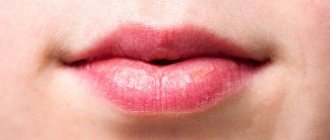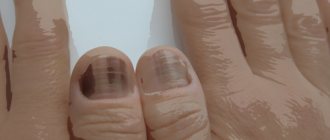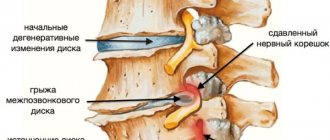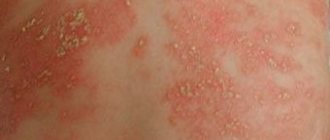When a person's health is satisfactory, the lips have a reddish or pinkish tint. It is not surprising that this indicator has become a guarantee of beauty: pink lips symbolize health, while blue in this area is scary. Blue lips are a dangerous symptom that you should definitely pay attention to. Especially if the blue discoloration lasts for a long time and does not disappear. Blue lips may indicate a number of problems that are worth discussing separately.
This phenomenon may indicate problems with blood supply, as well as pathology of the respiratory tract and concomitant diseases. All these aspects deserve special attention.
Causes of blue lips
Cyanosis, as blue lips are scientifically called, is not a separate disease, but a symptom that accompanies a number of diseases and conditions, both harmless and dangerous. Lips turn blue mainly due to the fact that deoxyhemoglobin accumulates in the blood in very large quantities. That is, the blood does not receive the volume of oxygen it needs and darkens.
Darkened blood is clearly visible in those areas where the layer of skin is initially thin. And lips are normally red precisely because blood vessels are visible here, this is an area with a thin layer of epidermis. This is easy to verify - everyone sometimes has skin peeling off their lips; it is transparent, not red or pink.
Interesting: Physiology of the red blood cell
Types of pathology, accompanying symptoms of cyanosis
Lips turn blue from cold
Central cyanosis gives a bright blue color to the lips and cheeks, it occurs due to problems with blood circulation, due to which carbonic anhydride accumulates in it. There is also peripheral cyanosis, which occurs due to a decrease in the rate of blood circulation in the vessels, due to stagnation, which provides the blood with the accumulation of carbon dioxide. Cyanosis also occurs due to the fact that venous and arterial blood mixes in the human body. In this case, the person experiences increased breathing. If in the first situation cyanosis is usually provoked by increased stress on the body, and sometimes by hypothermia, then in the second it occurs due to cardiovascular pathologies.
Blue discoloration of the nasolabial triangle
Blue discoloration of the nasolabial triangle.
Very often, parents turn to the pediatrician with complaints about blue discoloration around the lips, or, as it would be more correct to say, cyanosis of the nasolabial triangle. What is this and is it worth worrying about this issue, we will now consider.
The nasolabial triangle is an area on the face limited by the nasolabial folds on the sides, the nose above and the lips below. Cyanosis can be caused by physiological (i.e., occurs in absolutely healthy babies) and pathological (various diseases) conditions of the body.
Physiological conditions.
In the area of the nasolabial triangle, the blood supply is highly developed: both arterial and venous vessels are present. And the skin of infants and young children is very thin and delicate, so the vascular plexuses seem to “shine through” through it and it appears bluish.
Baby crying . Sometimes mothers note that cyanosis appears when crying or prolonged screaming. This is due to the peculiarity of the pulmonary system in newborns. At this time, the level of oxygen in the body decreases (its amount can decrease by up to 92%), and the capillaries expand from tension and are therefore clearly visible through thin skin. In medicine, this phenomenon is called pulmonary cyanosis, and does not pose any threat to health. It disappears when the baby calms down. As the child grows up and lung function improves, this symptom goes away.
Feeding. Sucking at the breast is a big burden for the baby, during which capillaries appear and become visible near the surface of the skin. After feeding, the blueness goes away immediately.
Low air temperature . When your baby is cold, some parts of the body, including the nasolabial triangle, may turn blue. This is due to the imperfect heat exchange system of the child’s body. As soon as the baby warms up, the skin will take on a natural color. The same thing happens while walking. If you notice a blue nasolabial triangle, it’s time to leave the street, because this may be the first sign of hypothermia in a child.
We have reviewed with you the physiological conditions of cyanosis of the nasolabial triangle in children, which are not associated with the manifestation of any diseases. What pathological conditions can lead to the appearance of this symptom?
Pathological conditions.
Respiratory diseases. Respiratory diseases that can lead to cyanosis of the nasolabial triangle include ARVI, pneumonia, bronchial asthma, obstructive or allergic bronchitis, that is, those that lead to impaired air exchange. Of course, along with cyanosis, other symptoms of these diseases should be present (fever, nasal discharge, prolonged dry cough). In this case, you cannot do without consulting a pediatrician, who in turn can refer you to other specialized specialists.
Foreign objects. This is another common cause of cyanosis of the nasolabial triangle. Little children are very curious. Their taste buds are best developed, and therefore they experience the whole world through their mouth. Everything that interests them ends up in the mouth - one careless breath and a tiny object ends up in the respiratory tract. The child begins to cough heavily and gasp for air. It is necessary to provide first aid and call an ambulance.
First aid for a foreign body in the respiratory tract : Turn the child face down and tap the back with force, but not excessively. It is better to carry out manipulations over a sofa or armchair so that the baby does not fall on the floor and accidentally slip out of your hands.
Second option. Sit in a chair or chair. Place your baby face down on your left knee. Your left palm should be on his chest and support his neck. With your right hand, make strong pushes with the edge of your palm between the shoulder blades towards the mouth. Additionally, induce vomiting in the child by pressing your fingers on the root of the tongue. Follow all steps until the ambulance arrives.
Neurological pathology. Very often, cyanosis can be observed in children who experienced hypoxia or asphyxia during birth (for example, when entwined with the umbilical cord), and were also born premature. We see a blue nasolabial triangle in children with increased intracranial pressure and immature brain structures. In any case, consultation with a neurologist is necessary.
Congenital heart defects . Cyanosis of the nasolabial triangle in a child is one of the first signs of congenital heart disease and heart failure. To clarify the diagnosis and timely treatment, it is necessary to conduct an echocardiogram (ultrasound of the heart), an ECG and consult a cardiologist.
Problems with the development of the respiratory system. Malformations of the bronchopulmonary system (tracheal stenosis, bronchial hypoplasia, etc.) can also lead to cyanosis of the nasolabial triangle. Such conditions require urgent treatment.
Poisoning with drugs or chemicals. Poisoning causes tissue hypoxia, which is manifested by impaired absorption of oxygen by cells, hence cyanosis of the nasolabial triangle. Cyanosis will also be observed in children in whose presence their parents smoke, as a consequence of nicotine intoxication.
If the doctor, after examining the baby, did not find any pathologies and recognized cyanosis of the nasolabial triangle as normal, the following measures should be taken so that the blue discoloration disappears as soon as possible.
Be sure to take your child for a walk in the fresh air every day. Long walks will not only strengthen the baby’s body, but also saturate it with oxygen. And if there is no deficiency, then the nasolabial triangle will not turn blue.
Don't let your baby cry for too long. This is harmful not only to the physical health, but also to the emotional comfort of the child. Crying is a form of communication accessible to the baby to the mother. By crying, the child tries to draw her attention to some factors that cause him discomfort (wet diaper, hunger, loneliness and others). Provide him with everything he needs.
Monitor the air temperature in your baby's room. It should not be too hot or cold. Ideally - 21-25 degrees. If your child starts to feel cold, just dress him warmly (in clothes made from natural fabrics so that the skin can breathe).
Why do lips turn blue in the cold?
Oxygen-poor blood is darker.
The most common occurrence is blue lips due to cold, but this is not the only reason. Blue lips due to cold are associated with a narrowing of blood vessels that react to low temperatures. The blood supply deteriorates, the blood stagnates, acquires a bluish tint due to the fact that it gives off oxygen before reaching the peripheral tissues. This is where the specific color comes from. A lack of oxygen in the room also causes blue lips, as does an overdose of certain drugs and increased physical activity.
Prevention
To prevent cyanosis of the lips, it is recommended to promptly treat the underlying diseases and lead a healthy lifestyle. At the first signs of a disorder, refrain from self-medication and consult an experienced doctor. Prevention of cardiovascular and respiratory diseases (the main diseases causing symptoms) is aimed at:
- diet correction: preferable plant-based, whole grain foods, rich in whole oils, fiber, protein
- normalization of sleep
- quitting smoking and drinking alcohol
- introduction of moderate physical activity: daily walks in the fresh air, swimming, yoga, therapeutic exercises
- compliance with the work and rest schedule
- reduction of psycho-emotional stress
Self-medication may not have the desired effect and provoke the development of complications.
Cyanosis is one of the signs that is observed in patients with diseases of the blood, heart and blood vessels, and respiratory system. In order to prevent it, it is recommended to follow all doctor’s recommendations during therapy. Take medications regularly and without skipping, attend physical therapy sessions. The patient is recommended to be under constant supervision of specialists until there is a lasting improvement in overall well-being. It is important to direct efforts to prevent diseases that cause blue lips and to lead a healthy, active lifestyle.
Other reasons
Lips turn blue when poisoned, due to tobacco and alcohol, under anesthesia, when a person is undergoing surgery. But not all reasons for blue lips are so harmless; there are other reasons that are definitely worth paying attention to. Blue lips can be a dangerous symptom, indicating a serious illness or dangerous condition in a person.
Pulmonary thrombosis, asthma, bronchitis - all these diseases cause blue lips. Pneumonia or bronchitis can also have this effect. These diseases affect the respiratory tract, preventing oxygen saturation in the blood. A long stay under water causes blue lips, again due to a lack of oxygen, which could not be inhaled, and at high altitudes the lips turn blue due to thin air - this is important for climbers and parachutists.
Interesting: Why does the tongue go numb? Reasons, what to do, photos and videos
Problems of the cardiovascular system can also affect the color of the lips, since poorly circulating blood will quickly release oxygen without bringing it to the peripheral tissues, which will turn blue.
Which doctor should I contact?
At the first time the skin of your lips turns blue, it is recommended to consult a therapist. In the future, consultation with a cardiologist, hematologist or pulmonologist may be required. It is not recommended to try to treat the symptom yourself, as this can aggravate the course of the underlying disease and provoke complications. The sooner the patient receives consultation from an experienced, qualified specialist, the more favorable the prognosis.
Choose a specialist, read reviews and make an appointment with a therapist online
Why do my child's lips turn blue?
Sometimes blue lips are observed in a child. This may indicate danger. The specificity of childhood cyanosis is the underdevelopment of the respiratory organs, or the entry of a foreign body into the larynx. The first case is typical for newborns; the pathology is detected immediately after the birth of the child. Modern possibilities make it possible to save such a baby. As a rule, premature babies are born with underdeveloped lungs, up to 32 weeks of pregnancy.
When crying
A foreign body can enter the larynx at any time, at any age, creating breathing problems. A child may choke on food or put a toy or bead in his mouth. If you suspect that a child is choking, you need to immediately provide him with help. Blue lips can be observed when crying for a long time - at such moments the body also does not receive enough oxygen; for complete ventilation of the lungs, calm, measured breathing is necessary.
Thus, there are many reasons why lips may turn blue, but they all come down to a lack of oxygen in the blood. There may be little oxygen due to its deficiency in the air, due to illness or improper functioning of the respiratory system, due to slow blood circulation, which loses oxygen before reaching the peripheral areas of the body. Blood deprived of oxygen acquires a dark color; it is this that colors the lips blue instead of the usual pinkish or reddish.
Interesting: Why is there blood? Reasons, how to stop, what to do, photos and videos
Diagnostics
To diagnose cyanosis, vital signs such as pulse, respiration, temperature, and blood pressure are assessed. The patient is asked about the presence of a cough, the regularity of colds, and the use of medications. The doctor takes into account the medical history (presence of heart defects, rheumatism, respiratory pathologies), conducts a general examination, pays attention to the condition of the throat, pharynx, lymph nodes, and the severity of cyanosis. Conduct objective research:
- pulse oximetry
- gasometry
- general blood analysis
- ESR
- spirography
- bronchoscopy
- general urine analysis
- blood test for glucose, inflammatory markers
- chest x-ray
- computer and magnetic resonance imaging
- also take into account the body's response to the oxygen therapy involved
Depending on the suspected underlying disease and the diagnostic results obtained, an electrocardiogram, echocardiography, or computed tomography of the chest may additionally be recommended. Pathological hemoglobins are also determined.










